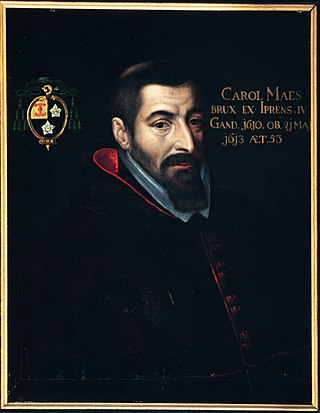Related Research Articles

Albert VII was the ruling Archduke of Austria for a few months in 1619 and, jointly with his wife, Isabella Clara Eugenia, sovereign of the Habsburg Netherlands between 1598 and 1621. Prior to this, he had been a cardinal, Archbishop of Toledo, viceroy of Portugal and Governor General of the Habsburg Netherlands. He succeeded his brother Matthias as reigning archduke of Lower and Upper Austria, but abdicated in favor of Ferdinand II the same year, making it the shortest reign in Austrian history.

Isabella Clara Eugenia, sometimes referred to as Clara Isabella Eugenia, was sovereign of the Spanish Netherlands, which comprised the Low Countries and the north of modern France with her husband, Archduke Albert VII of Austria.

A Joyous Entry is the official name used for the ceremonial royal entry, the first official peaceable visit of a reigning monarch, prince, duke or governor into a city, mainly in the Duchy of Brabant or the County of Flanders and occasionally in France, Luxembourg, Hungary, or Scotland, usually coinciding with recognition by the monarch of the rights or privileges to the city and sometimes accompanied by an extension of them.

Wenceslas Cobergher, sometimes called Wenzel Coebergher, was a Flemish Renaissance architect, engineer, painter, antiquarian, numismatist and economist. Faded somewhat into the background as a painter, he is chiefly remembered today as the man responsible for the draining of the Moëres on the Franco-Belgian border. He is also one of the fathers of the Flemish Baroque style of architecture in the Southern Netherlands.

Princely Count Charles of Arenberg, duke of Aarschot, baron of Zevenbergen, knight of the Order of the Golden Fleece, was the second Princely Count of Arenberg and a leading aristocrat of the Habsburg Netherlands, who served as a courtier, soldier, minister and diplomat.

Jean Grusset dict Richardot, knight was a statesman and diplomat from the Franche-Comté, who held high political office during the Dutch Revolt and played an important role in restoring Habsburg rule in the Southern Netherlands.

Matthijs Langhedul was a Flemish organ-builder who did important work in Paris. He and Crespin Carlier had great influence on the development of the classical seventeenth century French organ.

Juan de Mancicidor was secretary of state and war to the Archduke Albert from 1596 to his death in 1618.

Lodewijk Verreycken, Lord of Impden, Sart, Ruart, Hamme was secretary of the Council of State of the Habsburg Netherlands and audiencier of the Privy Council of the Habsburg Netherlands. He played an important role as a diplomat and emissary of the Spanish crown and the Habsburg Netherlands in various peace negotiations in Europe, including the Peace of Vervins with France and the Twelve Years' Truce between Spain and the Dutch Republic.

Engelbert Maes (1545–1630), was chief-president of the Privy Council of the Habsburg Netherlands and Council of State from 1614 to 1630, making him a central figure in the government of the Habsburg Netherlands for sixteen years.

Rutger Velpius was a 16th- and 17th-century printer and bookseller. He was the first printer in the city of Mons, and later became printer to the court in Brussels. His career coincided closely with the first decades of the Dutch Revolt
Events from the 1590s in the Spanish Netherlands and Prince-bishopric of Liège.
Jacques Blaseus (c.1540–1618) was successively bishop of Namur and bishop of Saint-Omer in the Spanish Netherlands.

The Privy Council or Secret Council was one of the three "collateral councils" that together formed the highest government institutions of the Habsburg Netherlands. Based in Brussels, it was particularly charged with legal and administrative questions.
Gilles du Faing, lord of Linay and Griffemont, baron of Jamoigne, was a soldier and diplomat in the service of Philip II of Spain and the Archdukes Albert and Isabella.
Events in the year 1600 in the Spanish Netherlands and Prince-bishopric of Liège.

Karel Maes, Latinized Carolus Masius (1559–1612) was bishop of Ypres and later bishop of Ghent in the Habsburg Netherlands.
Jacobus Maes or Jacob Maes (1505–1569) was a lawyer and public official in the Habsburg Netherlands, serving as the pensionary of the city of Antwerp and a member of the Privy Council of the Habsburg Netherlands.
References
- ↑ Nobiliaire des Pays-Bas et du comté de Bourgogne, vol. 2 (Ghent, 1865), 1271-1272.
- ↑ Bram De Ridder and Violet Soen, "The Act of Cession, the 1598 and 1600 States General in Brussels and the Peace Negotiations during the Dutch Revolt", in The Twelve Years Truce (1609): Peace, Truce, War and Law in the Low Countries at the Turn of the 17th Century, ed. Randall Lesaffer (Leiden and Boston, 2014), p. 56n.
- ↑ Bruno Boute, Academic Interests and Catholic Confessionalisation (Leiden and Boston, 2010), p. 103.
- ↑ Mireille Jean, La Chambre des Comptes de Lille (1477-1667): L'institution et les hommes (Paris, 1992), p. 254.